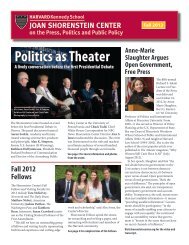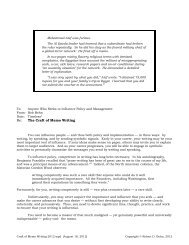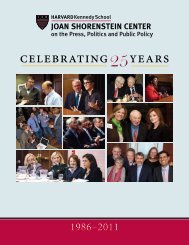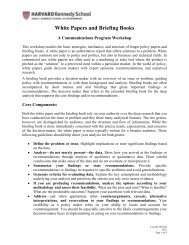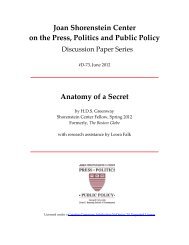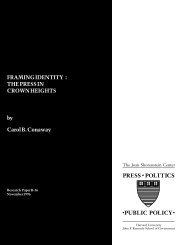A User-First Framework for Sustaining Local News - Harvard ...
A User-First Framework for Sustaining Local News - Harvard ...
A User-First Framework for Sustaining Local News - Harvard ...
You also want an ePaper? Increase the reach of your titles
YUMPU automatically turns print PDFs into web optimized ePapers that Google loves.
The Money Goes to the Niches<br />
Consumers are spending a lot of money <strong>for</strong> in<strong>for</strong>mation online, but not much on<br />
local news. Forrester Research projected spending of nearly $3 billion in 2009 on<br />
in<strong>for</strong>mation and services from such sites as The Wall Street Journal, Match.com and<br />
ConsumerReports.org. 47<br />
Forrester’s Sarah Rotman Epps estimated that only 3 percent of Internet users in the<br />
U.S. have paid to access digital in<strong>for</strong>mation—and that the average household income of<br />
those who have is nearly $100,000. She urged publishers to be sure their offers satisfy<br />
three requirements be<strong>for</strong>e attaching an online price tag: compelling content, the right<br />
targeting (customers already predisposed to spend money on such products) and “smart<br />
device integration” on iPhones, Blackberries and other tools in common use. 48<br />
In a separate Forrester report, researcher Nick Thomas warned against viewing “the<br />
Web as a panacea <strong>for</strong> the historic decline in print,” adding: “It would be nice to see<br />
online revenues making up <strong>for</strong> the shortfall in print subscriptions, thus allowing<br />
publishers to carry on as they are, but that’s not going to happen any time soon. The<br />
Web is a separate, increasingly important medium and must evolve on its own terms.”<br />
Thomas steered publishers toward specialized content: “<strong>News</strong> will be free, but paid<br />
opportunities will arise around niche verticals. Smart publishers and advertisers will<br />
focus on content channels where brand values and expertise coincides with readers’<br />
passions or their needs: This could be around wine, books, music or travel, <strong>for</strong><br />
example—or around personal finance or content <strong>for</strong> professionals.” 49<br />
James Hamilton, director of the DeWitt Wallace Center <strong>for</strong> Media and Democracy at<br />
Duke University, suggests, “One way to make sense of the many different types of news<br />
offered in the market is to categorize demands <strong>for</strong> in<strong>for</strong>mation by the types of decisions<br />
that give rise to the demands.” In his 2004 book, All the <strong>News</strong> That’s Fit to Sell, he<br />
recounts earlier research by Anthony Downs that sorts people’s desire <strong>for</strong> in<strong>for</strong>mation<br />
into four functions: “consumption, production, entertainment and voting.” 50<br />
Government in<strong>for</strong>mation has been a lucrative part of the in<strong>for</strong>mation industry <strong>for</strong><br />
decades, but powered mostly by users combining special interests beyond citizenship<br />
and the wherewithal to pay high prices <strong>for</strong> the in<strong>for</strong>mation. I found at least a couple of<br />
15




